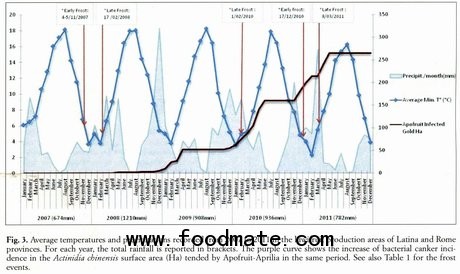Relation between climatic parameters and PSA on gold kiwifruit


Published: 2012-10-12 Origin: freshplaza Views:
28
Core Tip: To establish possible relationships between some major climatic parameters and the occurrence of initial epidemics of "bacterial canker" of yellow-fleshed kiwifruit in Latium region, climatic data were recorded by weather stations established in the areas
To establish possible relationships between some major climatic parameters and the occurrence of initial epidemics of "bacterial canker" of yellow-fleshed kiwifruit (Actinidia chinensis) in Latium region, climatic data (maximum, minimum and average temperature as well as rainfall) were recorded by weather stations established in the areas of yellow-fleshed kiwifruit cultivation and related to epidemiological investigations. A recent paper, issued by the Journal of Plant Pathology, reports on a study made in co-operation between the Consiglio per la Ricerca e la Sperimentazione in Agricoltura, Roma and Apofruit-Italia, Latina, on these aspects.
There is an obvious relationship between the frost events of 2007-2008 (i.e. November and February) and the first outbreaks of bacterial canker observed on A. chinensis. In the orchards, the first visible signs of the disease (i.e. leaf spotting) were observed in May-June 2008, as confirmed by isolations performed in that period, whereas the first signs of canker formation along the trunk and leader appeared in November-December 2008.

A clear-cut increase in bacterial canker spreading was also observed after the severe late frost of February 1st 2010, as well as after the frost events of winter 2010-2011. In addition, in 2008 the total precipitation in the kiwi-growing area of Latium was 1,210 mm, i.e. 30- 35% higher than the yearly average of 850-900 mm. In particular, October and November 2008 were very rainy, a condition that may have contributed either to the initial massive spread of Psa or to its rapid multiplication (i.e. canker formation) in the very susceptible A. chinensis cvs Hort16A and Jintao.
[ News search ]
[ ]
[ Notify friends ]
[ Print ]
[ Close ]






